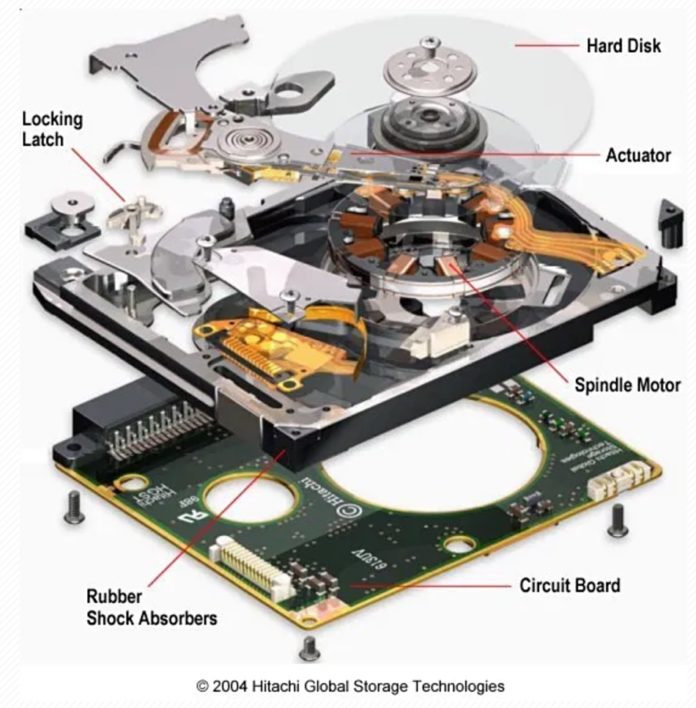Just five more years and spinning will be over. That was the opinion of Pure Storage several weeks ago when it said it believed SSDs would kill off the hard disk drive business by the end of 2028. But Jerome Lecat, CEO at object storage software supplier Scality has scoffed at this idea when we asked him about it. Paul Speciale, Scality’s Chief Marketing Officer, has now answered B&F’s follow-up questions.
Blocks & Files: Some all-flash-array suppliers suggest SSDs will be lower cost overall, in TCO terms, than HDDs by 2028 because of NAND price declines, electricity price levels and electricity availability. Do you think that QLC SSD acquisition cost (and maybe PLC later), with data reduction built in or not, will equal and then drop below HDD acquisition cost?

Paul Speciale: Since we are partnered with nearly all industry-leading server platform providers, we get a unique overview of the true costs of storage media across the HDD and SSD spectrum. When comparing today’s high-density Large Form Factor (LFF) HDDs to current QLC based flash SSDs, vendor data shows that HDD capacity pricing is between 5 to 7 times lower on a $ per GB basis today. In addition, these vendors project that HDDs will retain 4-5X cost-advantages into 2028.
While data reduction techniques can overcome these cost differences for certain types of application data, they cannot do so for all data (compressed video is the usual example). Most enterprise data protection (backup) applications already perform data compression & deduplication on backup data. We also have customers in Life Sciences where genomics data is pre-compressed, so there is no advantage to storing it on an all-flash system beyond random file IO performance for a relatively small amount (10 percent) of hot data (the remaining 90 percent is tiered to RING scale-out object storage with HDDs for data storage capacity).
These workload and data variances make it challenging for flash-based systems to truly overcome a 5X cost disadvantage in all cases. The reality today is therefore:
The promise of cost parity for flash SSDs with equivalent HDDs has not yet arrived.
High-density HDD will retain a ~5x cost advantage over high-density SSDs for many more years.
Flash vendors will not be able to eliminate this media price disadvantage through data reduction techniques for backup and other unstructured data workloads.
Blocks & Files: It’s taken as a truism that SSDs use less electricity than HDDs. Why would you think this is or is not the situation in a storage system?
Paul Speciale: For all types of drives, average power consumption will depend on workload characteristics.
From flash vendor spec sheets we see that high-density QLC flash drives consume 5W (idle), 15W (read) to 20W (write) per drive (see Micron’s data sheet and Kioxia’s data sheet).
For high-density HDDs, power consumption ranges between 7W (idle) and 9.4W (max) per drive (see Seagate’s data sheet).
In summary, we don’t believe that there is a sufficient difference in terms of power consumption for this to be the key buying criteria for customers.
Blocks & Files: If SSDs and HDDs use the same or approximately the same electricity in watt/TB terms then what cost factors other than acquisition costs can be used by enterprises to differentiate between SSD and HDD storage?
Paul Speciale: The buying criteria will come down to use-cases: QLC flash is warranted for more latency-sensitive, read-intensive workloads, whereas HDDs are now proven over the long term and optimal for most other petabyte scale unstructured data workloads.
How would you compare the working life of SSDs and HDDs? Is one longer than the other? Do they have the same enterprise refresh period?
All vendors across these drive types offer five-year warranties on their drives. In addition, flash vendors place a recommended maximum Drive Write Per Day (DWPD) on their drives, which impact the workloads for which they are suitable so customers need to be careful not to exceed these ratings.
Blocks & Files: How would you compare the rack density of shelves of SSDs versus shelves of disk drives? Do you think that shelves of HDDs in a rack need more or less cooling than shelves filled with the same capacity of SSDs?
Paul Speciale: We are doing additional analysis on density and cooling characteristics and will follow up when this concludes.
Blocks & Files: How do you think enterprises should calculate the cost of HDD storage vs the cost of SSD storage
Paul Speciale: As stated previously, the key considerations are related to the use cases/workload characteristics. This will determine whether or not the higher cost of flash media will deliver meaningfully better performance for the application (and again, flash delivers benefits mainly for latency-sensitive, read-intensive workloads).
Scality as a software-defined storage provider supports all types of drives including HDD and high-density flash, and our value proposition doesn’t depend on any specific drives. We therefore really don’t have a horse in the race between flash and HDD. Ultimately what matters is customers and the problems they are trying to solve. Today, we have seen that the longer term proven nature of HDD in terms of density, durability and price/performance make them the optimal solution for most multi-petabyte object storage use cases. This is especially true for backup applications which are write-heavy workloads that do not benefit from the lower latency of flash media.







